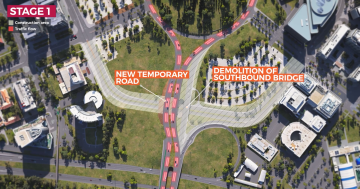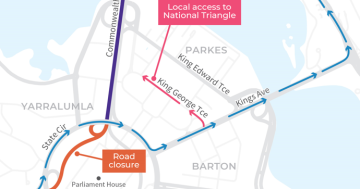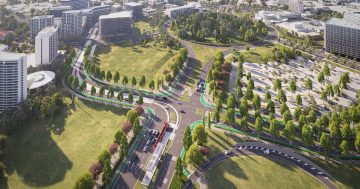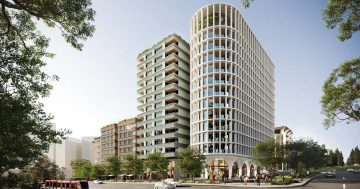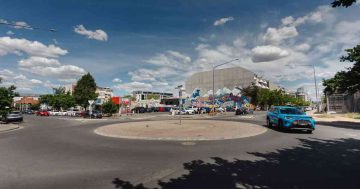
The City Hill Precinct – the heart of the city. Photos from the tender documents.
The ACT Government is looking at raising London Circuit to meet Commonwealth Avenue in the City Hill Precinct to create even street frontages, a more pedestrian and cycle-friendly area, greater connections to West Basin and Civic West, and easier access to future light rail stops.
The plans are part of a City Renewal Authority business case referred to in CRA tender documents for a consultancy team to develop an Estate Development Plan for the Section 63 City land release, as part of the City Hill Precinct. Morris Property Group is developing the other part of Section 63 into the Barracks residential precinct.
The tender documents say the CRA proposal will increase the amount of land that could be developed in the City Hill Precinct, in addition to providing a possible alternative design option for Stage 2 of light rail to Woden. But the CRA says only a small amount of extra land would be realised and the main purpose is to achieve a better urban design outcome. The plan would only affect one corner of the light rail route but it would make it easier for commuters to get to light rail stops from nearby blocks.
The 22,000 square metre site is at the centre of the City Hill precinct, fronting City Hill Park, and is a key connection to Lake Burley Griffin and the West Basin area. It is bounded by Vernon Circle to the north, London Circuit to the south, Commonwealth Avenue to the east, and Edinburgh Avenue, once complete in 2020, to the west.
At present, it is a sealed car park, with a ‘clover-leaf’ off-ramp connection from Commonwealth Avenue to London Circuit.
CRA CEO Malcolm Snow says the Authority was investigating the possibility of raising the road level of a short section of London Circuit so that it created a new at-grade intersection with Commonwealth Avenue.
He said this would be achieved by reconstructing about 100 metres of London Circuit and removing the existing bridge-underpass on Commonwealth Avenue.
“The authority is investigating this proposal because it believes there are a number of significant urban design benefits to having an at-grade intersection, including the ability to create active street frontages on both London Circuit and Commonwealth Avenue, with improved connectivity between the adjacent future development sites. It would also improve access for pedestrians and cyclists between the city centre and Lake Burley Griffin,” he said.
Mr Snow said the proposal was not about providing more land but creating a more accessible and efficient road configuration that supported good development with active street frontages.
“It also allows for light rail to be accommodated in the median, rather than needing a separate on-off ramp, which results in a slight increase to the amount of developable land on the southern side of London Circuit,” he said.
He said an at-grade intersection supported active street frontages on all sides and would improve safety, accessibility and connectivity for pedestrians, cyclists and cars, allowing people to move easily in different directions without having to change from one street level to another.
“The current grade-separated configuration was created at a time when traffic engineers prioritised cars above people. At-grade intersections are now widely-considered to provide a superior urban design outcome that creates a better place for people, particularly pedestrians,” Mr Snow said
Apart from allowing a possible light rail route to remain within the London Circuit median until it turns on to Commonwealth Avenue, an at-grade intersection would have little to no impact on the operation of light rail, but it would improve connectivity between the surrounding blocks, making it easier for people to access potential light rail stops.
The cost of the proposal would be $20-30 million.
The CRA business case is listed among concurrent infrastructure-related planning activities that may impact the Section 63 Development Strategy, which envisages up to 1000 dwellings on the site.
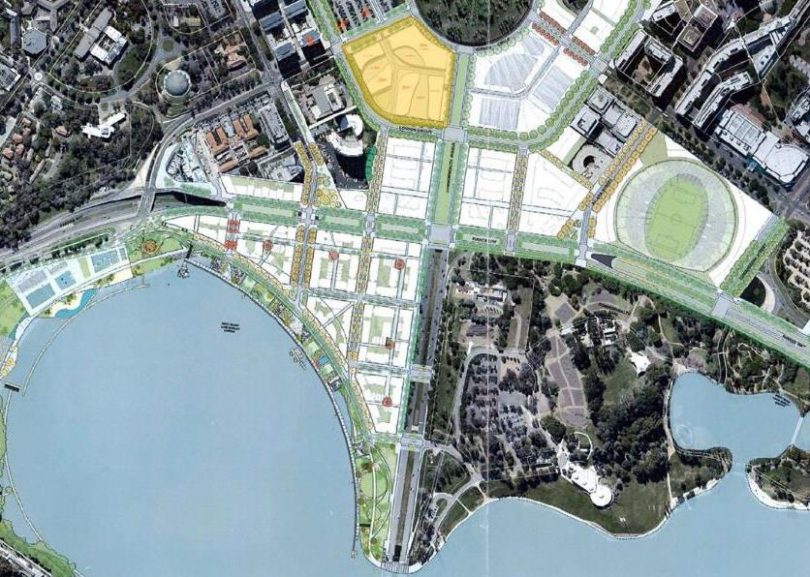
Section 63 City site is marked in yellow.
The Indicative Land Release Program lists a Section 63 City land release of 350 dwellings in 2019-20 financial year, followed by another 350 the next year and another 350 the year after that.
Approvals will be required from the National Capital Authority and Transport Canberra and City Services to enable the land releases.
The documents say City Hill is considered the ‘pre-eminent heart’ of the Canberra CBD and planning for Section 63 City should promote the value of place making and the role it plays in stimulating the public realm including traffic management, high-quality spaces and economically sustainable active street frontages.
The site should be considered in the context of it being an entry-point to the parliamentary zone and its relationship with West Basin, where up to 2000 apartments may be built, with any development meeting community expectations.
It should also be integrated with surrounding planned and existing developments, particularly the neighbouring Section 100 which is currently under way, and include art and local cultural influences to create a uniquely Canberra look and feel.
Other infrastructure planning referred to includes Edinburgh Avenue, the Woden light rail route and London Circuit.
The tender documents say the CRA business case for the raising of London Circuit and associated intersection works will “provide an alternative design option for the Canberra City to Woden Light Rail pathway, plus form up the boundary of Section 63 and surrounding lots, increasing the developable land area and providing an improved shape and street frontage”.













